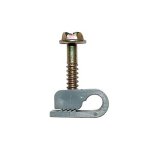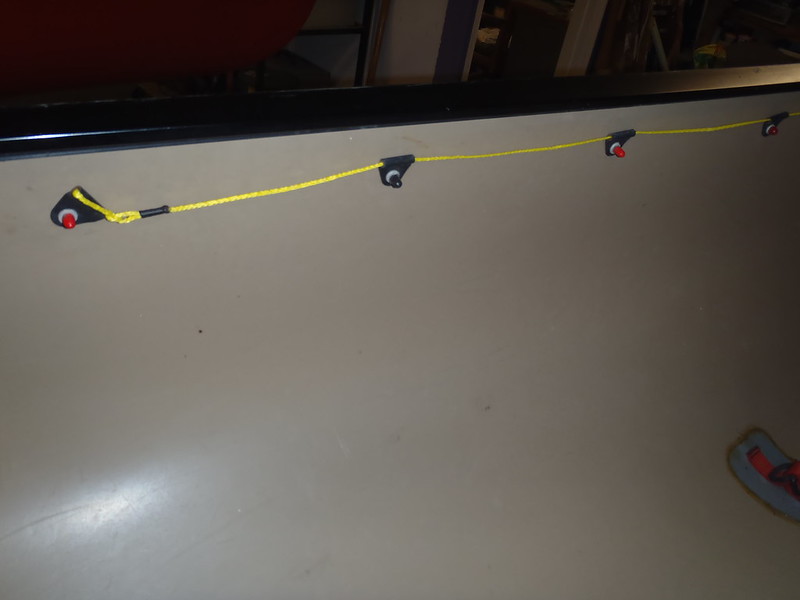“I have used stainless sheet metal screws to attach about a thousand nylon pad eyes (inchworms) to synthetic gunwales on a considerable variety of canoes. Never had a screw pull out.”
I prefer pad eyes for a lot of applications. Having two pop rivets (or screws) holding the attachment rather than just one more than doubles the strength by decreasing any twist or wooblewobbly wear on a single drilled hole.
Pad eye weight bearing capacity is overkill for most things, but I use Surf-to-Summit back bands, with swivel clips attached to pad eyes, in most of our boats. I don’t lean back Barcalounger sprawled against the back bands, but do use it for minor oppositional force in conjunction with a foot brace. Even with all of the weight carried by the front straps attached to a pad eye on either side I probably
could recline; a single pad eye pop riveted to a vinyl inwale held 163lbs before one of the two rivets pulled out of through the 1/8” thick vinyl.
 P4080007
P4080007 by
Mike McCrea, on Flickr
“A screw can be tightened to the degree desired unlike a pop rivet. By not quite tightening the screw as much as it possibly can be, the P clips can be rotated outward under the inwales when not in use. That way there is nothing sticking out to snag gear or break off or just make the gunwale uncomfortable to grab with the hand.”
Pop riveted cable clamps can be rotated under the inwale, although it does require a little more finger ouchie, at least for the first few times. I suspect some rivet head wear against the plastic cable clamps makes repeated rotations easier.
If a pop rivet in a hollow synthetic gunwale needs to be removed, as they sometimes do by drilling off the head, the interior portion of the rivet remains rattling around inside the gunwale and can be difficult or impossible to remove. I find that perpetual rattling to be quite annoying.
I have needed to drill out pop rivets in vinyl gunwales when soloizing a tandem. After the head is drilled off I punch the remains of the rivet pin loose into the inwale channel, and the rattle of the smushed mandrel and pins
is annoying. Enough so that I’ve stood some canoes on end and thumped on the gunwales, so the loose mandrel heads cascaded out the open ends of the inwale channel.
The disgorgement sound was reminiscent of a cactus rainstick, satisfying because the dang mandrel heads were finally gone.
FWIW, the synopsis of the weight bearing experiment results, something I had long wanted to do just to satisfy my own curiosity. That was the most fun and most revelatory experiment yet. And the most strenuous; I picked up and restacked a couple thousand pounds of weights from the shop floor after the clang-bang-smash crashing down failures.
Attachments,
Failure Weights,
How Failed and
Suppositions as to why things failed from that experiment:
Nylon webbing pop riveted through vinyl gunwale,
30lbs
Webbing pulled through 3/16” rivet head
Nylon webbing with fender washer pop riveted through vinyl gunwale,
60 lbs
3/16” Rivet pulled out of vinyl gunwale
Poly webbing pop riveted through vinyl gunwale,
70 lbs
Webbing pulled through 3/16” rivet head
Poly webbing with fender washer pop riveted through vinyl gunwale,
80 lbs
3/16” rivet pulled out of vinyl gunwale
Thoughts and suppositions:
Webbing loops need a washer under the pop rivet. OK, I already knew that.
Thin nylon webbing will pull through a washer more easily than thick poly webbing. No surprise there either.
3/16” pop rivets through thin (1/16” thick) vinyl gunwale will pull through the gunwale between 60 and 80lbs. The thicker/sturdier the webbing the more weight it held, perhaps because the weight was less likely to pull sideways, bending and sheering the pop rivet.
Grommet strap pop riveted through vinyl gunwale,
114 lbs
3/16” rivet pulled out of gunwale
Thoughts and suppositions:
OK, not a fair comparative test, the weights were pulling on the grommet strap sideways, not straight down. It definitely takes more weight to pull a pop rivet from a vinyl gunwale in that orientation. I am still impressed that the grommet strap itself held 114lbs
Nylon pad eye with dual pop rivets through vinyl gunwale,
163lbs
One of two 3/16” rivet pulled out of gunwale.
Thoughts and suppositions:
Two pop rivets are better than one. And I’m more a fan of those nylon pad eyes than ever; those are where my swivel snap Surf to Summit back bands are attached.
Weird plastic webbing connector (no pop rivet, hung via webbing),
95 lbs
Plastic broke
Thoughts and suppositions:
I dunno, whatever that skinny thingamadoodle was made of it held an impressive amount of weight. I only used it because I had one in the parts box. The type of plastic, nylon, derlin, etc obviously makes a strength difference.
Plastic Cable clamp pop riveted through vinyl gunwale with 3/16” pop rivet,
41.4lbs
Plastic clamp broke
Thoughts and suppositions:
Way more weight than I thought one of those would hold. The elongation before failure should have been no surprise.
Spray cover stud and mini SS D-ring pop riveted through Royalex sheet with 1/8” pop rivet,
124.5lbs
Rivet broke
Spray cover stud and webbing loop with 1/8” pop rivet on Royalex sheet,
171.5lbs
Rivet broke
Thoughts and suppositions:
Wow! A lot more weight than I would have predicted using a 1/8” pop rivet. Backing up spray cover studs is now a given.
Mini SS D-ring with 1/8” pop rivet affixed to aluminum gunwale,
82.5 lbs
Rivet broke
Webbing loop with 3/16” pop rivet on aluminum gunwale,
55 lbs
Rivet broke
Thoughts and suppositions:
Note the reduction pop rivet failure weights. I believe the aluminum gunwale helped sheer the aluminum pop rivet. And that was pulling straight down; pulling sideways might be even worse.
I tried using 3/16” steel pop rivets once. That was a nope with my hand pop rivet gun; I couldn’t even begin to squeeze them closed. I have a box of 24 left, 3/16” dia X 3/8” long, large flange steel. Free to good home.
Under-inwale D ring plastic tab with 3/16” pop rivet,
151lbs
Plastic tab tore.
Thoughts and suppositions:
Again, seriously stronger than I would have thought. A decent solution for under aluminum gunwales.
Eye screw in wood gunwale,
76.5lbs
Eye screw hole straightened out (long before weight limit was reached)
Thoughts and suppositions:
The eye screw loop straighten out, probably starting at 50lbs or so. Kinda predictable.
Cable clamp screwed in wood gunwale,
51.5 lbs
Plastic clamp broke
Thoughts and suppositions:
The elongation was comical to behold, but even those winky attachments held more weight than I anticipated.
Webbing loop screwed in wood gunwale with cup washer, 282.5 lbs
Webbing tore through cup washer
Webbing loop screwed in wood gunwale with flange washer,
320 lbs
Webbing tore through flange washer
Thoughts and suppositions:
Those both held a lot of weight. Flange washers helps. Better webbing would have helped as well. Dabbing epoxy in the screw holes made no difference, except that I couldn’t back the screws out when done.
Pad eyes screwed in wood gunwale (with smaller screw heads),
146 to 157 lbs
Screw heads pulled through nylon pad eyes
Pad eye screwed in wood gunwale (with larger screw heads),
300+ lbs
Nothing failed, I just gave up, although that pad eye was bent like crazy.
Thoughts and suppositions:
Size does matter, at least when it comes to screw heads in nylon pad eyes. Again, nylon pad eyes, with two pop rivets or screws, will hold a tremendous amount of weight. Also Mike will give up at 300lbs weight and call it good.
 P4030002 by Mike McCrea, on Flickr
P4030002 by Mike McCrea, on Flickr P4030003 by Mike McCrea, on Flickr
P4030003 by Mike McCrea, on Flickr P4090040 by Mike McCrea, on Flickr
P4090040 by Mike McCrea, on Flickr P4040017 by Mike McCrea, on Flickr
P4040017 by Mike McCrea, on Flickr P4050002 by Mike McCrea, on Flickr
P4050002 by Mike McCrea, on Flickr P4050004 by Mike McCrea, on Flickr
P4050004 by Mike McCrea, on Flickr P4050014 by Mike McCrea, on Flickr
P4050014 by Mike McCrea, on Flickr P4050024 by Mike McCrea, on Flickr
P4050024 by Mike McCrea, on Flickr P4100006 by Mike McCrea, on Flickr
P4100006 by Mike McCrea, on Flickr
 P2170545 by Mike McCrea, on Flickr
P2170545 by Mike McCrea, on Flickr P3200679 by Mike McCrea, on Flickr
P3200679 by Mike McCrea, on Flickr P4060004 by Mike McCrea, on Flickr
P4060004 by Mike McCrea, on Flickr P4030006 by Mike McCrea, on Flickr
P4030006 by Mike McCrea, on Flickr P4080007 by Mike McCrea, on Flickr
P4080007 by Mike McCrea, on Flickr